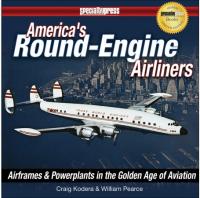
America’s Round-Engine Airliners
by Craig Kodera and William Pearce
Hardbound, 10 " x 10" x 0.7", 216 pages
ISBN-13: 978-1-580072-649
Specialty Press (2019)
Recommended Retail Price: $46.95
300 color, 200 black and white photos
Book Reviews 9
 |
America’s Round-Engine Airliners Hardbound, 10 " x 10" x 0.7", 216 pages Recommended Retail Price: $46.95 300 color, 200 black and white photos |
Reviewed by Kimble D. McCutcheon - 18 Jun 2019
This book traces the evolution of American air travel from its beginnings to the end of scheduled service aboard large piston-engine airliners. It places particular emphasis on the enabling technologies that made air transport advances possible, especially the engine advances. It also weaves the complex tales of airlines' rises and falls, their owners and their unique requirements.
Coauthors Craig Kodera and William Pearce are well credentialed to relate this story. Kodera, whose father worked in the California aerospace industry, flew for the U.S. Air Force, Air Force Reserve, and civilian airlines. He is also a well known freelance aviation artist. Kodera writes about the aircraft. Pearce grew up in a fly-in community and has a lifelong interest in engines, WWII aircraft and racing. As a lifetime AEHS Member, his Duesenberg and Studebaker aircraft engine books are well known as is his oldmachinepress.com website. Pearce writes about the engines.
Regularly-scheduled commercial aviation grew from the Government air mail contracts resulting from the 1925 Kelly Act, which transferred air mail service from the U.S. Government to private carriers. Early mail/passenger aircraft were powered by WWI surplus Liberty engines, but the introduction of more reliable air-cooled radials, the Wright Whirlwind in 1925 and the Pratt & Whitney Wasp in 1926 paved the way for future airline growth. Boeing, Curtiss, Fairchild, Fokker, Ford and Stinson, to name but a few, produced monoplane and biplane transport aircraft with one, two, three or four radial engines. Airlines and the aircraft industry were feeling their way into the new air transport industry.
The twin-engine all-metal monoplane was what evolved. The 1933 Boeing 247 was the first of these, followed quickly by the Douglas DC-1, DC-2 and DC-3. While these sleek, fast and safe aircraft served well within the continental United States, flying boats were the logical choice for Caribbean and trans-oceanic air travel. Sikorsky, Martin and Boeing produced the luxurious craft.
Landplanes also grew in size, range and luxury. The largest ones all used four engines. Boeing produced the 307 and 377; Douglas produced the DC-4, DC-5, DC-6 and DC-7; Lockheed answered with the Constellation series. The complexity of these aircraft resulted in the introduction of another crew member in addition to the traditional pilot and copilot – a flight engineer to mind the engines and aircraft systems. Kodera admirably covers the key aircraft, airlines and people of this amazing era.
Pearce's engine segments are interspersed among Kadera's aircraft sections. Pearce begins by covering aircraft engine fundamentals including configuration, fuels, supercharging, propeller reduction gearing, engine cowlings and installation. He covers early radial engine history, especially that of Wright Aeronautical, Curtiss and Pratt & Whitney. He details the development history and development challenges of numerous engines, with lots of photographs and diagrams of engines and their internals. Engines covered are the Lycoming R-680; Pratt & Whitney's R-1340 Wasp, R-1690 Hornet, R-1860 Hornet B, R-1830 Twin Wasp, R-2000 Twin Wasp, R-2180 Twin Wasp, R-2800 Double Wasp and R-4360 Wasp Major; and Wright's J-4, J-5 and J-6 Whirlwinds, R-1820 Cyclone, R-2600 Twin Cyclone 14, R-3350 Duplex Cyclone 18 and R-3350 Turbo-Cyclone 18.
Lavishly illustrated with beautiful color and black/white photographs, this volume is a fun, nostalgic read that also includes much history.
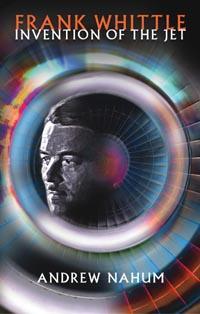 |
Frank Whittle: Invention of the Jet Hard Cover, 178 x 114 x 22 mm, 160 pages Recommended Retail Price: £ 9.99 |
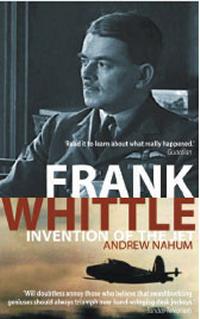 |
Frank Whittle: Invention of the Jet Soft Cover, 198 x 130 x 15 mm, 192 pages Recommended Retail Price: £ 6.99 |
Reviewed by Les Waters
For more than half a century Frank Whittle has received abundant recognition of his technical brilliance and indefatigable devotion to his task in developing the turbojet to a status of viability. The dissemination of technology from his small team to the major British engine manufacturers and General Electric in the United States was critical in providing an expeditious launch to their efforts to design and produce this revolutionary engine.
However, along with this recognition of his many accomplishments, is widespread perception that his greatest was that of achieving them despite poor government support and a lack of understanding by senior officials of the potential of the turbojet engine.
This book, written by the Senior Curator of Aeronautics at the Science Museum in London, is overdue in giving a discerning review of the complex events which ultimately lead to turbojets entering wartime service with the RAF. The author makes the case that Whittles efforts were well supported by the government, when the demand from competing critical defense projects is understood.
Senior RAF officers soon recognized Whittles brilliance, his early scholarly achievements, after a RAF apprenticeship leading to him being given the ultimate technical education that the RAF could offer. At Cambridge University he took the Mechanical Tripos, then stayed for a further graduate year. His first engine design took shape during his time at Cambridge.
Whittle needed financing to give his ideas reality in metal. Through the efforts of Ralph Dudley Williams and JCB Tinling, two ex-RAF officers of a company, Power Jets was established to develop the engine and to finance further patents. These activities soon benefited from the involvement of Sir Henry Tizand, chairman of the Engine Sub-Committee of the Aeronautical Research Committee and a widely respected figure in aeronautical affairs. Tizand soon became a solid supporter of Whittle's work and remained so through the life of the project. From the beginning of his work in Power Jets, Whittle had good and influential friends in the RAF and in top government scientific circles. This is well demonstrated by Hayne Constant, a government scientific officers engaged in studies for a turboprop engine. His support included the proposal that Whittle should be provided with six engines for his development tasks.
Private financial support at this stage was considered useful in launching the company activities, partly to limit knowledge of the project and to also allow an expeditious start. The Air Ministry was a party to the start of the company, though not a stockholder. They contributed Frank Whittle as Chief Engineer, placing him on "special duty" as acknowledgment of his pivotal role.
With approximately £5,000 spent on the technical effort in just over a year from its inception, the need for further financing became critical. Further private sources were only minimally forthcoming even though the engine had achieved test running status. Financial support from the Air Ministry, although promised, was slow to materialize but became fully effective by late 1939.
The unusual contracting procedures were inhibiting to the Air Ministry, who were more familiar with transactions involving the large existing engine companies. While these companies were privately owned businesses, as was Power Jets, its uncertain more entrepreneurial nature, caused officials to hesitate to commit funds. Also, the years of design and testing of the Power Jets engines, 1936 to 1939 was a time of turmoil in the Air Ministry as an urgent expansion of the RAF was under way. The Whittle engine was one of many activities. The development of radar, of interceptor tactics and communication systems, of new concept aircraft and their advanced engines, made severe demands on Air Ministry staff.
Whittle received on different occasions two very important visitors to his test bed in early 1940; Arthur Tedder, a senior RAF officer and Air Marshall Sir Hugh Dowding, Chief of Fighter Command both experienced Whittles charm and charisma. Despite the very primitive facilities of Power Jets the engine concept was seen by these officers as a "potential war winner".
The third design of engine had produced successful test results into initial runs in 1939 and this improved attitudes in the Air Ministry. David Pye, Director of Scientific Research, observed a run at 16,000 rpm which greatly impressed him, changing him from doubtful to becoming an enthusiastic supporter of Whittle.
Optimism in officialdom was such that by the end of 1940 the decision was made to proceed to production engines, albeit in small numbers. An engine was built from new components to power an experimental aircraft, a Gloster-built machine designated the E28/39. Subsequent to a highly successful flight test program the decision was made to design a larger engine, the W2. This was to be the production engine for a twin engine fighter, which subsequently entered service as the Meteor. Although Power Jets was charged with the task of designing this engine, a contract to produce the engine was awarded to the Rover Car Co. As a manufacturer of high class automobiles, this company was believed by the Air Ministry to be competent to execute this work. The Ministry staff realized that this step was likely to offend Power Jets.
As handed to Rover, the W2 engine was not a fully detailed design, a condition which resulted inevitably in Rover initiating design features and design changes. This added to tensions between the two companies. The decision to produce the W2 before a prototype had run was remarkable. The engines produced powered the first 20 Gloster Meteor fighters which performed with modest success in service.
Since Frank Whittle perceived Power Jets as being the design authority for the jet engines, design features originated by Rover lead to a strained relationship. This acrimony was further sharpened when Rover designed a new engine incorporating a "straight through" layout instead of the reverse flow layout incorporated in previous Whittle engines. Frank Whittle had favored the latter arrangement to achieve a short engine to minimize shaft whirling problems. Power Jets were not told of the new engine design work at the outset, becoming greatly offended when aware of it. The acrimony between Rover, Power Jets and the Ministry of Aircraft Production lead to activity on the "straight through" engine being minimized. It was in early 1943 that Rolls Royce, now having taken over the Rover work applied their resources to the reverse flow W2B and to the straight through B26. Rover staff lead by Adrian Lombard became Rolls Royce employees.
Rolls Royce quickly transformed the status of the two engine designs. Further boosting of the jet engine derived from the arrival of Sir Stafford Cripps as Minister of Aircraft Production. He showed an immediate appreciation of the potential of the jet engine for both wartime use and technical advances in British aviation. One result of this was to be a new, uniquely aviation college. This trend in his thinking lead to his favoring nationalization of Power Jets which by this time had been largely financed by the government. Cripps was however concerned to acknowledge and make due reward to the Power Jets team for their pioneering work during air Ministry tepid financial support.
Crimps, an ascetic by nature and a barrister by profession had some familiarity with engine development from having acted for Ricardo Consulting engineers in litigation involving non-licensed use of their combustion system designs. With several of the existing British aircraft engine companies now effectively developing jet engines, albeit utilizing much of the Power Jets work, Cripps believed that they could be a major contributor to a government research establishment. Attempts to negotiate the value of Power Jets were not successful. The Ministry of Aircraft Production now moved to acquire the Power Jets establishment, making total payments of $135,000 to its original investors. Total government financing to the company was $103 million, an amount 60 times that of private investment.
News of the engine program was announced to the public on the same day that Power Jets were informed of the intent to nationalize the company. The nationalization process involved a wide reorganization, all engineers and scientists at the Royal Aircraft Establishment working on gas turbine projects being merged into the Power Jets Ltd. organization. The new board of directors comprised strong members from industry and government, with Tinling and Williams from the original Power Jets team.
The company had become a substantial organization, in contrast to the impecunious early days. Staffing had-risen to 1,327 people by April 1945. Facilities included three large aircraft as flying test beds and a 4,000 hp compressor test rig. In this much expanded status, the company was capable of becoming the recognized national center for gas turbine technology, as perceived by Cripps and his senior staff. It would be an effective technical resource to exploit the capabilities of Whittle and his team.
But the team showed little enthusiasm for working in research projects. After working directly in the design and development of complete engines they saw a future in research as unexciting. Until this time Whittle had hoped that Power Jets would return to its position as engine designers, an idea strongly resisted by the existing aircraft engine companies, who insisted on their own design freedom. A few months into the existence of the new form of company (Power Jets R&D), Whittle resigned, followed by 20 of the early staff members over the following six months.
A change of name to The National Gas Turbine Establishment was made on July 1, 1946. This company supported the British gas turbine industry executing basic research projects.
The last four chapters of the book discuss the efforts of Britain to establish a course for the development of civil airliner fleet, hopefully exploiting Britain's lead in gas turbine technology. The effort was lead by Lord Brabazon, a prestigious figure in British aviation and specifications for a range of aircraft were developed. Brabazon was well aware of the formidable capability of the U.S. aircraft industry, where at the time, some 13 designs of mufti-engine civil aircraft were in development, with none in Britain. The U. S. was also acquiring extensive experience in international transport activities where they were operating 1,000 aircraft, four times as many as the British were.
A substantial impediment to progress in the design of civil aircraft was the RAF virtual monopolization of aeronautical capability to work on military aircraft. An exception was the effort by de Havilland in designing and producing the Comet aircraft. The transformation for passengers, in speed and refinement was revolutionary when British Overseas Airway Corporation (BOAC) started Comet Service in 1952. This technological leap enhanced British prestige in aircraft design until eighteen months later when the first of several mysterious failures occurred.
The investigation of the failures was conducted by the Royal Aircraft Establishment, lead by Arnold Hall. Closely watched by aircraft designers in the U.S., some of the test techniques were adapted by them. Re-design of the Comet provided a much larger aircraft and new engines, but the four and a half years this task covered meant that it entered service only a short time before the Boeing 707 was available and operated by BOAC.
There is a short review of gas turbine history in the U.S. and Germany during the 1930s and in wartime. The providing of a Whittle engine to GE is well known, but many other projects were active in the U.S. though even today this is not so widely realized. In Germany the government provided wide support to existing engine companies only minimal support going to Hans von Ohain, the original inventor. This section concludes with a follow-up of the post-war careers of leading engineers and teams from Germany, several of them developing further careers in the United States.
In this little book Nahum skillfully analyses the many complex factors affecting the Whittle engine development. From the one-man genesis by Whittle he shows that support for the project, generated initially by his charisma and later by his technical success, won him many advocates in the RAF and the highest technical government places.
The critical days of the mid 1930s to 1940 stretched government funding and management resources to the limit, but the Whittle project received effective support resulting in remarkable progress. As Power Jets achieved successful sustained text operation, the handing over of their technology to the British aircraft engine companies gave them an invaluable launch to their jet engine designs, saving them perhaps three years time in achieving viable engines.
Frank Whittle emerges from this book with his reputation fully intact. His technical genius and dedication as a Royal Air Force Officer, including his declining to claim a monetary share of the payment made to the original Power Jets shareholders at the time of nationalization speak to his great character.
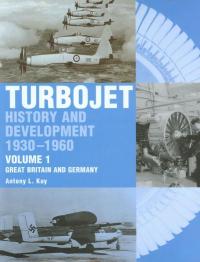 |
Turbojet History
and Development 1930-1960 Hard Cover, 280 x 220 mm, 372 pages Recommended Retail Price: £40.00 300 black & white photographs and drawings. |
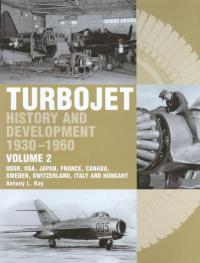 |
Turbojet History and Development 1930-1960 Hard Cover, 280 x 220 mm, 372 pages Recommended Retail Price: £40.00 300 black & white photographs and drawings. |
Reviewed by Douglas G. Culy
A.L. Kay has produced two volumes from his extensive files on turbine engines that cover most of the early history of turbojet, turboprop, and turboshaft engine development. The good news is that there are many, many photos and much historic detail not before put in any publications this reviewer has seen in his 47½ years of participation in and observation of the engine business. For those reasons alone, these two books are must-haves for our libraries. The bad news is that some engines are mentioned without photographs or historic details. One possible explanation for part of this omission is the great difficulty of getting permission from some picture holders, who are also writers or publishers, to use their photos. Regretfully, several great early sources of historic detail seem not to have been used. Kay gives almost equal coverage to the airplanes that used these engines, which is useful, but not as satisfying as having those pages devoted to more engine discussion. There are also a few absolute errors of historic detail, coming from the books perhaps not having been carefully reviewed by other knowledgeable engine historians.
The best presentation is of Whittle's work, with more illustrations than in larger treatments of Whittle. Rolls-Royce's work seems somewhat truncated. This may have prompted a Rolls-Royce Heritage Trust reviewer of Volume 1 to chide Kay for the use of kiloponds rather than kilograms or pounds for engine thrust. It should be noted that some schools taught that units of mass should be distinguished from units of force, and that indiscriminant use of "pounds" was not satisfactory for purists. Therefore, Kay is careful in using the proper and harder-to-confuse term.
Metrovick's engines are not all discussed, leaving Metropolitan-Vickers' contributions (as available in the U.S.) confined to a few publications of the late 1940s. However, the Armstrong-Siddeley discussion is thorough, as is that of Bristol engines.
Junkers and BMW engines are fully covered, but few of von Ohain's engine variants are omitted. The size comparison, on one page, of the German jet engines is still the best graphic explanation of the problem German airframe manufacturers had in readying the first jet aircraft for production. The Daimler-Benz effort is covered more thoroughly than elsewhere, and we are reminded that D-B or Metrovick produced the world's first turbofan engine. D-B's was also the first geared turbofan, of which type P&W is now finally putting much effort on.
Kay sheds much light on early Russian engine development, particularly that of Lyulka and Kuznetsov. He treats us to a few more pictures and a little more data on the NK-12 and its predecessors. It is a shame that more is apparently not available. Ditto for the P&WA PT-5/T57, both tying for the worlds largest turboprops, still; since it is yet to be demonstrated that Europrop can design, produce, and field a comparable engine today. The story of Klimov's Nene copy is further amplified, and the overall discussion of Russian engines is the best yet seen in the English language. This reviewer suspects that there will be more to come when Russian aviation historians focus on engines.
The Lockheed turbojet and turboprop engines that were non-starters are barely adequately covered, but the Northrop Turbodyne coverage is not even that; pictures and cross-sections of them are available elsewhere.
The early General Electric engines are well covered (except that the T58 is given short shrift), but those of P&WA are not. Missing, are the gas-generator for the PT-1, the full story on the predecessors of the JT3, and as mentioned above, more on the PT-5/T57. The connection between GE-Lynn and GE-Schenectady is well explained. The Westinghouse story starts out well, but finishes without even pictures and adequate story of the J40, J46, and J54 engines; the first two being important because of what problems their failures caused the airframe industry. Similarly, the Allison story shorts us on what that company put into the J33 and J35 programs, and a bigger story on the transition from the T38 to the T56.
The Wright Aeronautical story omits the T35, which was actually flown, and we don't see a picture of the T49 that also was flown. Nor do we get a good discussion of the effort that Wright did put in on their Americanizing of the British Olympus engine.
While Lycoming is mentioned, the details of the many models of the T53 and T55 are absent. Worse yet, Boeing's turboshaft engines are not even pictured, nor given significant discussion, even though Boeing pioneered several U.S. aviation turbine engine applications before 1960.
Discussion of Teledyne Continental is absent altogether. Fairchild's two aviation turbine engines are mentioned but the J83 is not adequately discussed. The GE and P&WA nuclear turbojets are discussed, but not pictured, although pictures have been published elsewhere. Strangely, the nuclear engine discussion pictures the JT-11 Blackbird engine, without discussing it.
The presentation of Japanese WWII jet engines is new and good. The French turbine engine story is also good, with satisfying detail on the origin of the Atar series as well as several other manufacturers' engines that also have not had much discussion in previous English-language histories. However; the Turbomeca story is short a number of its very prolific lines of engines.
The Canadian Orenda engine line is adequately presented, as are the Swedish Lysholm and STAL efforts, and the Swiss Escher-Wyss, Sulzer, Brown-Boveri, and EFW company efforts (the Swiss programs being a surprise, with a double surprise of their turbofan effort). The historic Hungarian Jendrassik turboprop engine is more fully discussed than yet seen, this ending Volume 2.
Engine data tables are presented in the back of both volumes, and it is hoped that later editions will include more design-point data. Both volumes are in 8 1/2 x 11 format and are well printed and bound.
In spite of the above criticism, which is meant to be constructive for the next editions of these two volumes, they are still must-have books.
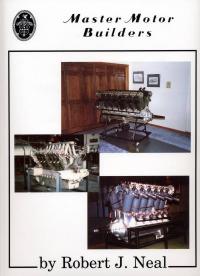 |
Master Motor Builders Hard Cover, 9 3/8" x 11 3/8", 366 pages Recommended Retail Price: US $65.00 More than 735 b/w & color |
Reviewed by Douglas G. Culy
Master Motor Builders is a tour-de-force of aircraft engine history. Bob Neal's work results from many years of deep and abiding interest in the Packard Motor Car Company; this book covers its non-automotive engines. Jesse G. Vincent, Packard's top engineer, was chiefly responsible for Packard's presence in aviation and marine engines, so this book is mainly the story of Vincent's commitment and contributions. It takes the reader from the progenitor of the Liberty through Packard's taking up and improving the Rolls-Royce Merlin to its efforts on turbojet and turbofan engines.
On the marine side, the reader is taken from speed boat racing in the 1920s to torpedo boats in WWII. Not only does Neal provide new information on the Liberty and Packard-Merlin, but he illuminates the many engines in between. Neal also provides satisfying illustrations of every model, and many Packard advertisements are also included. The relationship between the marine and aviation lines is made clear. There is also major discussion of Packard's aero and marine diesel engines, including radial, inline, and V-8 types. Ten appendices expand on engine design specifics, production statistics, applications, and relevant patents. A thorough bibliography is included.
Its paper and binding are of the highest quality, superior to that of most aviation books. This is an outstanding book and well worth its cost, even for the most demanding engine historian.
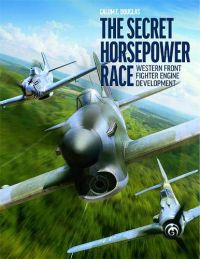 |
The Secret Horsepower Race Softbound, 8.6" x 11.7" x 1.1", 480 pages Recommended Retail Price: £35.00 (US $43.92) Numerous pictures/diagrams; black & white, color |
Reviewed by Ross E. Dunn – 5 Feb 2021
My primary interest in life since I was a teenager has been engines. They were magical things that you feed fuel and electricity to and they generate noise and power. I studied everything I could find on engines and fiddled with them at every opportunity I got. I was soon working on cars and became an auto mechanic. At technical college I discovered in the library a book called The Power to Fly by L.J.K. Setright. Here were pictures and descriptions of incredible engines that were so different from the car engines that I was familiar with. This opened up the field of aviation engines and I became a student of engine history and as I learned more I discovered the incredible development of engines that occurred in World War II. A lot of the technology that we use today goes back to this period.
The books I read told the story of Allied engine development but there was an almost total lack of information on the German engines. There were some pictures and a few diagrams but that was about it. Why did they mount their V-12s upside down? Why did the DB601 have roller connecting rod bearings? So many questions occurred to me and I wanted answers.
In 2016 I met Calum at the AEHS convention in Dayton, Ohio, saw his presentation and realized he had the same curiosity that I had about this period of intense engine development. Calum is in a perfect position to investigate this period. He is an engineer with a engine development experience and a deep understanding of the piston engine. He had worked in Germany for Toyota doing racing engine research and had learned German. So I have been eagerly awaiting his book.
The first thing that I can say about this book is that it is the result of an awful lot of research. Calum has dug up original documents to base this book on. He doesn’t copy from other authors and he doesn’t repeat hearsay; Calum goes to the source, which is thoroughly documented. He has also done interviews and has sourced private records. This approach of getting right to the bottom of things, is one of the strengths of this book. The big surprise for me is that it gives many insights into the allied story that were new to me.
The book tells a fascinating tale in logical and chronological order. The only negative that I can say is that a lot of the diagrams and graphs are printed too small. I suppose that this was done to keep the cost down but you will need a good magnifying glass to see the details.
To get the most out of this book the reader should already have a good understanding of piston engines and should know the major engines of World War II and the planes that they came in. If they know that then they are in for a very interesting read.
Further Remarks
by Kimble D. McCutcheon
I also was present in Calum’s 2016 presentation and have been looking anxiously forward to this book, which has not been without its challenges and delays. That any publisher would undertake a hard-backed, 480-page, highly-technical, color aircraft engine book during a global pandemic and at a time when nearly all print media is struggling to survive is, to my mind, a miracle. But Tempest did, producing an attractive, heavy, A-4 sized book, printed on high quality kaolin-coated paper that takes ink well and preserves incredible detail.
Table of Contents
Preface
Concerning Air Intelligence
Prologue
1. The Schneider Trophy
2. 1930s ‑ prelude to War
3. 1939 ‑ The Battle for Britain Begins
4. 1940 ‑ Britain Under Threat
5. 1941 ‑ The Air War Over Europe
6. 1942 ‑ The Turning Point
7. 1943 ‑ Germany on the Defensive
8. 1944 ‑ The Synthetic Fuel War
9. 1945 ‑ The End in Europe
10. Technical Overview
Archives Consulted, Nomenclature, 1,280 Notes, Index
In a chronological progression, each numbered chapter reviews developments in Britain, America, Germany, and to a lesser extent, France, Italy and the Soviet Union. The book’s breadth and depth is astonishing. It provides biographical sketches of the key personnel, and overviews of the political, financial and managerial backdrop. But more importantly, it introduces important technical concepts and then dives into the minutiae of engine design and construction. Not only are there the usual descriptions, images and drawings of assemblies and parts, but coming from the unique perspective of an engine designer, Calum explains why things were done the way they were.
This work started out as a book about superchargers, but in order to adequately address superchargers, Calum had to cover just about every other aspect of engine design and construction. What a tour de force!
Nearly every review of this book has mentioned the small illustrations. It is true that the book designer made unfortunate choices that resulted in some tiny illustrations. However, due to the high paper and print quality, I found none of them unreadable; a strong glass helps a lot. With this criticism in mind, Calum has created an image archive where most of the book’s images appear in glorious full size.
The Secret Horsepower Race is an important addition to any engine enthusiasts’ bookshelf. I think it will be revered as one of the most important aircraft engine references in existence.